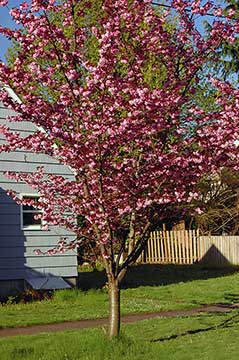Street Tree Committee
The City of Norwich Tree Committee conducts tree plantings and related activities for the City of Norwich.
Street Tree Committee Members: https://www.norwichnewyork.net/government/boards-commissions.php#trees
Benefits of Trees
Urban trees provide many benefits, including:
- Shade our homes and sidewalks
- Reduce cooling and heating costs
- Increase property values
- Improve wildlife habitat
- Reduce crime
- Reduce stormwater runoff
- Clean the air and water
- Capture and store carbon
- Encourage physical activities
- Improve physical and mental health outcomes for residents
- Decrease stress in residents
- Create a sense of community pride
- An environmental club for girls came across this Street Tree page while doing their trees and forestry project and found it extremely helpful. They reciprocated by sharing a link with us to learn even more on the importance of trees. Thank you, girls! playgroundequipment.com/outdoor-learning-the-importance-of-trees
Learn more about Tree Benefits at Trees Are Good (https://www.treesaregood.org/treeowner/benefitsoftrees) and Arbor Day Foundation (https://www.arborday.org/trees/index-benefits.cfm)

Tree Care
The Street Tree Committee reminds you to:
- Apply woodchip mulch in an even layer 2-4" deep around the base of your trees. Leave a little space around the trunk so air can circulate. Mulch will help retain moisture in the soil, add nutrients, reduce weeds, and protect the tree from lawnmower and string trimmer damage.
- Remove twinkly lights each season to allow for tree growth.
- Water newly planted trees every few days for the first few weeks, then taper off for the warm part of the year. Watering is one of the best ways to ensure the trees survive.
- Install a trunk protector on young trees to protect them from mower and string trimmer damage. Specific tree care and planting recommendations:
- Trees Are Good https://www.treesaregood.org
- Arbor Day Foundation https://www.arborday.org/trees/index-planting.cfm
- Cornell Urban Horticulture Institute https://blogs.cornell.edu/urbanhort/
- UMass Amherst Tree and Shrub Fact Sheets https://ag.umass.edu/resources/home-lawn-garden/fact-sheets/trees-shrubs
- University of Florida, Landscape Plants Page https://hort.ifas.ufl.edu/woody/index.shtml
Tree Planting
Occasionally, the City has funds to plant trees in front of homes and businesses. To learn more about upcoming tree planting or to request a tree, fill out the Tree Planting Request Form. (https://forms.gle/kCeUDiUk4f5q6UZE7.) All sites are reviewed for suitability by the Tree Committee before approval.
If you would like to plant a tree in the tree lawn and there is not an active tree planting initiative, please complete this form (COMING SOON). The DPW and the Tree Committee will approve all planting sites. Please see the list of recommended trees below.
Fall Leaf Pick-up
As of January 1, 2024 the City will no longer pickup plastic bags during the Spring and Fall yard waste pickup. To ensure pickup by the City DPW, yard waste and leaves must be in paper or bio-degradable bags. The Street Tree Committee endorses the use of paper bags to keep excess plastic out of our environment. City residents are eligible for up to 10 free leaf bags while supplies last. Bags can be picked up at City Hall.
City residents or business owners are eligible for up to 10 free paper leaf bags at City Hall for use in the City. More information is coming soon.
Recommended Street Trees
Street trees endure additional stresses such as road salt, exhaust, and compaction. Below is a list of trees the Street Tree Committee suggests for planting in tree lawns or other tough sites. Additionally:
- The City of Norwich is USDA Hardiness Zone 5, though planting Zone 4 trees is recommended.
- Do not plant trees considered to be invasive species. This includes Norway maple, Acer platanoides, (both green and purple varieties), Callery pear, Pyrus calleryana, and Japanese tree lilac, Syringa reticulata.
- The City has an abundance of honeylocust, Gleditsia triacanthos, crabapple, Malus spp., and maples, Acer spp., so we recommend planting other species to increase biodiversity.
- Many "full-sized" trees have ornamental varieties that are short or columnar and may be suitable for smaller spaces.
- Do not plant large trees under power lines as they will eventually interfere and be heavily pruned by the utility.
For information about individual trees, their varieties, potential pest problems, and landscape use, visit The Missouri Botanic Garden website: https://www.missouribotanicalgarden.org/PlantFinder/PlantFinderSearch.aspx
For information on insects and diseases and testing, please refer to the Cornell Insect Diagnostic Lab (http://idl.entomology.cornell.edu/) and the Cornell Plant Disease Diagnostic lab (http://plantclinic.cornell.edu/)
Large Trees
- Kentucky Coffee tree: Gymnocladus dioicus
- Elm: Ulmus spp- American Elm hybrids are available
- Ginkgo: Ginkgo biloba
- Hackberry: Celtis occidentalis
- Horsechestnut: Aesculus hippocatanum
- American Linden: Tilia americana
- Littleleaf Linden: Tilia cordata
- Freeman Maple: Acer freemanii
- Red Maple: Acer rubrum
- Bur Oak: Quercus macrocarpa
- English Oak: Quercus robur
- Shingle oak: Quercus imbricaria
- Red Oak: Quercus rubra
- Oak species: Quercus species and hybrids
- Swamp White Oak: Quercus bicolor
- Bur oak: Quercus macrocarpa
- White oak: Quercus alba
- London Planetree: Platanus x acerifolia
- Tulip-poplar: Liriodendron tulipifera
- Sweetgum: Liquidambar styracifula
- Northern catalpa: Catalpa speciose
- Bald-cypress: Taxodium distichum
- Dawn redwood: Metasequoia glyptostroboides
Medium Trees
- River birch: Betula nigra
- Hornbeam/musclewood: Carpinus species
- Ironwood: Ostrya species
- Chinese catalpa: Catalpa ovata
- Mongolian linden: Tilia mongolica
- Black gum: Nyssa sylvatica
- Yellowwood: Cladrastis kentukea
- Katsura tree: Cercidiphyllum japonicum
Small Trees
- Flowering cherry: Prunus serrulata
- Nanking cherry: Prunus tomentosa
- Sargent's cherry: Prunus sargentii
- Amur Maackia: Maackia amurensis
- Flowering crabapple: Malus species and hybrids
- Hawthorn: Crataegus species and hybrids
- Star magnolia (side streets): Magnolia stellata
- Eastern redbud (side streets): Cercis canadensis
- Serviceberry: Amelanchier species and hybrids
- Osage-orange: Maclura pomifera
